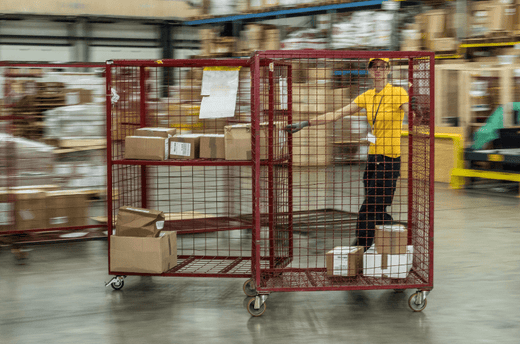Trolleys and roll cages are indispensable when moving goods efficiently around supermarkets. Under pressure to restock shelves quickly to prevent customers from being disappointed when their favourite products appear to be out of stock, it is critical that your staff have the tools and equipment to manoeuvre quickly and safely around the shop.
However, improper handling of trolleys and roll cages can lead to injuries to staff, put customers at risk, and inflict damage on shop fittings. By following proper techniques and safety measures and ensuring your equipment is correctly fitted with industrial wheels, your team can avoid preventable accidents and work more quickly and comfortably.
So, what steps can you take to promote the safe handling of trolleys and roll cages in your supermarket?
Provide Comprehensive Staff Training
All employees need regular training in the correct handling and movement of trolleys and roll cages. Proper instruction on pushing, pulling, lifting, and manoeuvring wheeled equipment reduces the risk of injuries, such as strains, muscle pulls, and slips, and ensures heavy equipment can be moved with control and precision. As well as onboarding new staff unfamiliar with your shop’s layout and routines, refresher courses are essential to keep experienced colleagues up to date with safe practices and the latest health and safety regulations.
Assess The Load
Before moving a loaded trolley or cage, staff should assess the load by estimating the weight and checking overall dimensions. It is important to ensure the load is stable and evenly distributed, with no heavy items stacked at the top or hanging over the edges. They should also confirm the load is within their lifting capacity: if it is too heavy or unwieldy, they should ask for assistance.
Pushing Over Pulling
Whenever feasible, trolleys and roll cages should be pushed rather than pulled. Pushing provides better load control and ensures staff can see where they are going, making collisions with customers, other equipment, or stock less likely. Employees can also use their body weight and leg muscles more effectively to start and stop when pushing, whereas pulling places excessive strain on the back, shoulders, and arms.
Inspect Equipment Before Moving
Most people are familiar with the problem of unruly shopping trolleys! Damaged or defective equipment may lead to accidents, so staff should regularly check that wheels roll smoothly, have no visible wear and tear, and that brakes and steering function properly. Clearly mark any faulty equipment and take it out of service until repaired or replaced.
Use proper Body Mechanics
As having the correct posture is crucial to prevent injuries when handling trolleys and cages, employees should follow these simple rules:
- Keep their back straight and use leg muscles to lift and push.
- Avoid twisting: move the feet instead.
- Slow down around corners, on uneven surfaces, and near colleagues and customers.
Contact Rolltek To Find Out More
For more information about how heavy-duty castors can improve trolley and roll cage safety in supermarkets, please get in touch with our expert team at Rolltek.
 Image source: Canva
Image source: Canva

